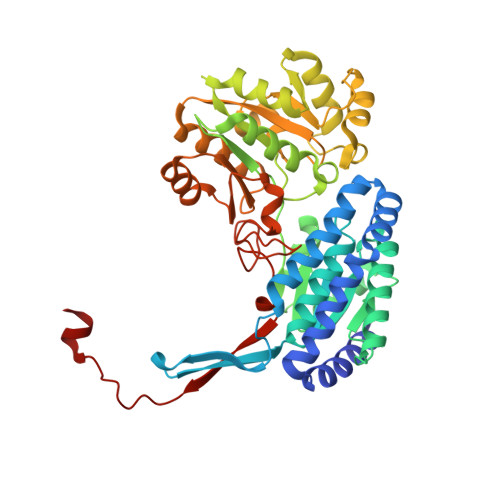Enhancing the Substrate Specificity of Clostridium Succinyl-CoA Reductase for Synthetic Biology and Biocatalysis.
Pfister, P., Diehl, C., Hammarlund, E., Carrillo, M., Erb, T.J.(2023) Biochemistry 62: 1786-1793
- PubMed: 37207322
- DOI: https://doi.org/10.1021/acs.biochem.3c00102
- Primary Citation of Related Structures:
8CEI, 8CEJ, 8CEK - PubMed Abstract:
Succinyl-CoA reductase (SucD) is an acylating aldehyde reductase that catalyzes the NADPH-dependent reduction of succinyl-CoA to succinic semialdehyde. The reaction sequence from succinate to crotonyl-CoA is of particular interest for several new-to-nature CO 2 -fixation pathways, such as the crotonyl-CoA/ethylmalonyl-CoA/hydroxybutyryl-CoA (CETCH) cycle, in which SucD plays a key role. However, pathways like the CETCH cycle feature several CoA-ester intermediates, which could be potentially side substrates for this enzyme. Here, we show that the side reaction for most CETCH cycle metabolites is relatively small (<2%) with the exception of mesaconyl-C1-CoA (16%), which represents a competing substrate in this pathway. We addressed this promiscuity by solving the crystal structure of a SucD of Clostridium kluyveri in complex with NADP + and mesaconyl-C1-CoA. We further identified two residues (Lys70 and Ser243) that coordinate mesaconyl-C1-CoA at the active site. We targeted those residues with site-directed mutagenesis to improve succinyl-CoA over mesaconyl-C1-CoA reduction. The best resulting SucD variant, K70R, showed a strongly reduced side activity for mesaconyl-C1-CoA, but the substitution also reduced the specific activity for succinyl-CoA by a factor of 10. Transferring the same mutations into a SucD homologue from Clostridium difficile similarly decreases the side reaction of this enzyme for mesaconyl-C1-CoA from 12 to 2%, notably without changing the catalytic efficiency for succinyl-CoA. Overall, our structure-based engineering efforts provided a highly specific enzyme of interest for several applications in biocatalysis and synthetic biology.
- Department of Biochemistry & Synthetic Metabolism, Max Planck Institute for Terrestrial Microbiology, Karl-von-Frisch Str. 10, 35043 Marburg, Germany.
Organizational Affiliation:
















